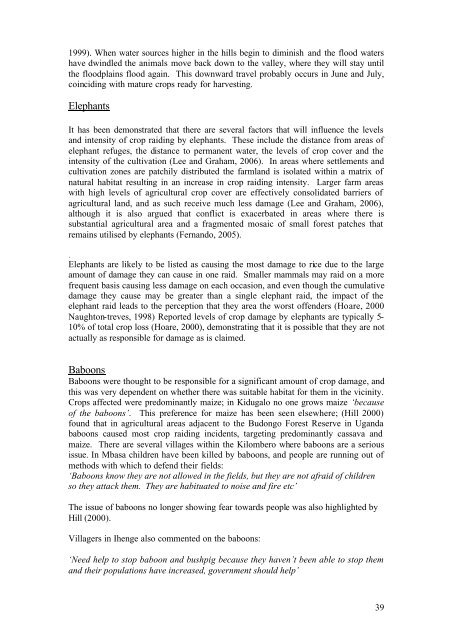Frontier Tanzania Environmental Research - Frontier-publications ...
Frontier Tanzania Environmental Research - Frontier-publications ...
Frontier Tanzania Environmental Research - Frontier-publications ...
You also want an ePaper? Increase the reach of your titles
YUMPU automatically turns print PDFs into web optimized ePapers that Google loves.
1999). When water sources higher in the hills begin to diminish and the flood watershave dwindled the animals move back down to the valley, where they will stay untilthe floodplains flood again. This downward travel probably occurs in June and July,coinciding with mature crops ready for harvesting.ElephantsIt has been demonstrated that there are several factors that will influence the levelsand intensity of crop raiding by elephants. These include the distance from areas ofelephant refuges, the distance to permanent water, the levels of crop cover and theintensity of the cultivation (Lee and Graham, 2006). In areas where settlements andcultivation zones are patchily distributed the farmland is isolated within a matrix ofnatural habitat resulting in an increase in crop raiding intensity. Larger farm areaswith high levels of agricultural crop cover are effectively consolidated barriers ofagricultural land, and as such receive much less damage (Lee and Graham, 2006),although it is also argued that conflict is exacerbated in areas where there issubstantial agricultural area and a fragmented mosaic of small forest patches thatremains utilised by elephants (Fernando, 2005)..Elephants are likely to be listed as causing the most damage to rice due to the largeamount of damage they can cause in one raid. Smaller mammals may raid on a morefrequent basis causing less damage on each occasion, and even though the cumulativedamage they cause may be greater than a single elephant raid, the impact of theelephant raid leads to the perception that they area the worst offenders (Hoare, 2000Naughton-treves, 1998) Reported levels of crop damage by elephants are typically 5-10% of total crop loss (Hoare, 2000), demonstrating that it is possible that they are notactually as responsible for damage as is claimed.BaboonsBaboons were thought to be responsible for a significant amount of crop damage, andthis was very dependent on whether there was suitable habitat for them in the vicinity.Crops affected were predominantly maize; in Kidugalo no one grows maize ‘becauseof the baboons’. This preference for maize has been seen elsewhere; (Hill 2000)found that in agricultural areas adjacent to the Budongo Forest Reserve in Ugandababoons caused most crop raiding incidents, targeting predominantly cassava andmaize. There are several villages within the Kilombero where baboons are a seriousissue. In Mbasa children have been killed by baboons, and people are running out ofmethods with which to defend their fields:‘Baboons know they are not allowed in the fields, but they are not afraid of childrenso they attack them. They are habituated to noise and fire etc’The issue of baboons no longer showing fear towards people was also highlighted byHill (2000).Villagers in Ihenge also commented on the baboons:‘Need help to stop baboon and bushpig because they haven’t been able to stop themand their populations have increased, government should help’39
















